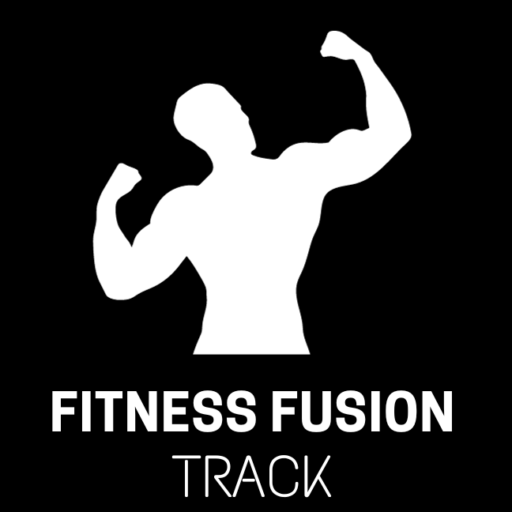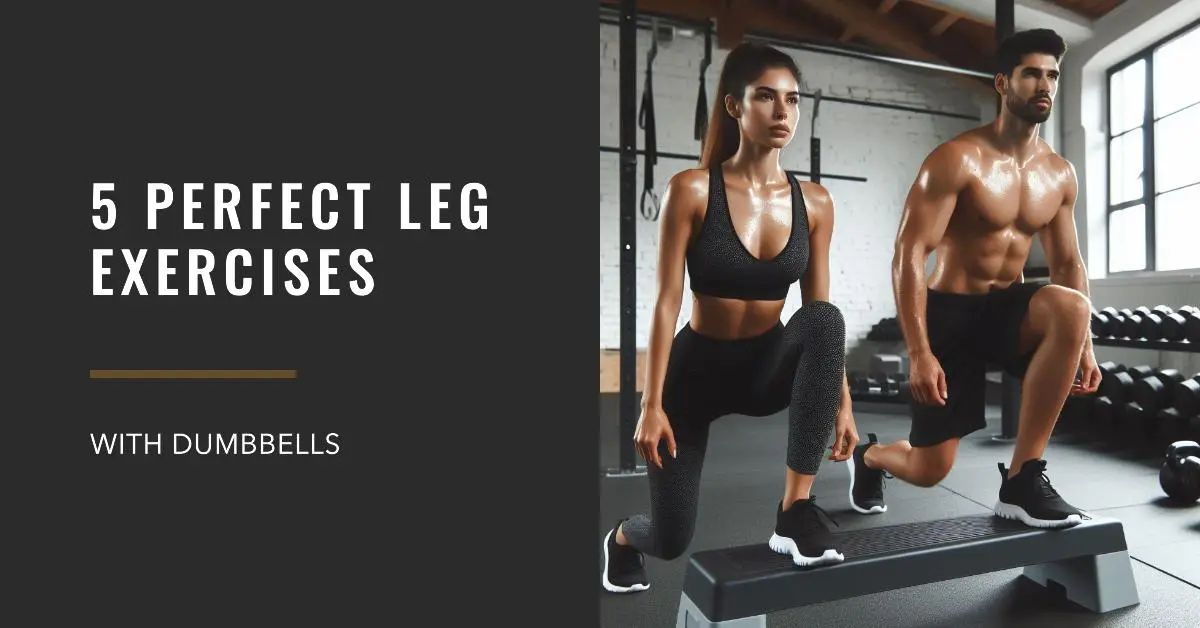Including leg exercises with dumbbells into your workout routine can take your fitness journey to new heights. These versatile tools offer many exercises to sculpt and strengthen your lower body. From targeting your quads to engaging your hamstrings and glutes, here are perfect leg exercises with dumbbells to elevate your routine. First, goblet squats provide a full leg workout while also improving core stability. Then, lunges with dumbbells in hand help build strength and balance. Don’t forget the deadlifts for targeting hamstrings and glutes, squats and step-ups round out the list, ensuring a well-rounded leg workout.
Benefits of Leg Exercises with Dumbbells
- Strength Building: Leg exercises with dumbbells help build strength in the quadriceps, hamstrings, glutes, and calves.
- Muscle Definition: These exercises can help define and sculpt your leg muscles, giving them a more toned appearance.
- Improved Balance and Stability: Dumbbells challenge your balance and stability, which can help improve overall lower body coordination.
- Joint Health: Strengthening the muscles around your knees and hips can help improve joint health and reduce the risk of injury.
- Convenience: Dumbbell exercises can be performed at home or in the gym, making them a convenient option for leg workouts.
Safety Precautions
When performing leg exercises with dumbbells, it’s important to follow safety precautions to prevent injuries. Consider the following particular points:
- Use a Stable Surface: Perform the exercises on a stable surface, such as a workout mat or gym floor, to prevent slipping or loss of balance.
- Use Appropriate Footwear: Wear supportive athletic shoes to provide stability and reduce the risk of injury.
- Breathe Properly: Breathe during the activity, being sure to exhale during the exertion phase and to inhale during the rest period.
- Avoid Overtraining: Allow proper rest between workouts to prevent overtraining and give your muscles time to recover.
- Listen to Your Body: If you experience pain or discomfort during an exercise, stop immediately and seek medical advice if needed.
Following these safety precautions can help you perform leg exercises with dumbbells safely and effectively.
Warm-Up Exercises
Warming up correctly is important before beginning any leg exercises with dumbbells. Start with dynamic stretches like leg swings and hip circles to loosen up your muscles. Follow up with bodyweight exercises like squats and lunges to activate your leg muscles. Including these warm-up exercises into your routine can help prevent injuries and ensure you get the most out of your leg workout with dumbbells.
Leg Exercises with Dumbbells
Squats
In a basic lower body workout, squats work the quadriceps, thigh muscles, glutes, and calves. Adding dumbbells to your squats increases the resistance, making the exercise more challenging and effective. To perform a dumbbell squat, hold a dumbbell in each hand, stand with your feet shoulder-width apart, and squat down as if sitting back into a chair. After then, take a straight back and raise your chest to retake the beginning posture.
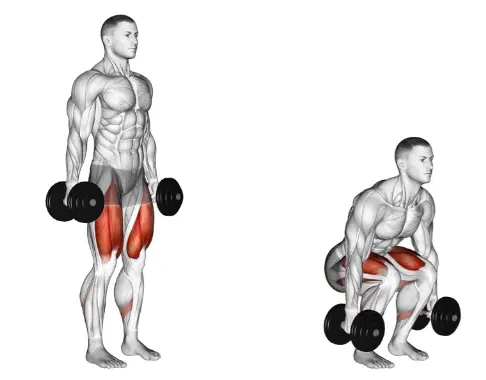
Lunges
Lunges are a great way to work your glutes, hamstrings, and quadriceps. Holding dumbbells in each hand while performing lunges adds resistance, making the exercise more intense. To do a dumbbell lunge, stand tall with a dumbbell in each hand, take a large step forward, and lower your body until both knees are bent at a 90-degree angle. Return to the beginning position by pushing, then switch to the other leg.
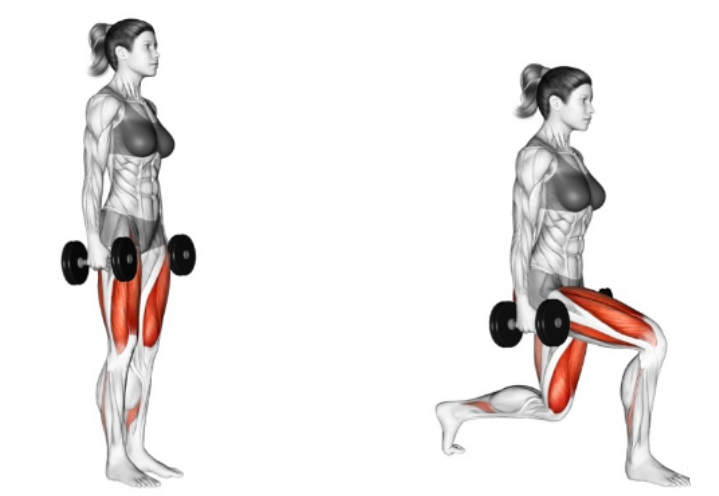
Step-ups
Step-ups are great for working the quadriceps, hamstrings, and glutes, as well as improving balance and coordination. Hold a dumbbell in each hand, stand facing a sturdy bench or step, and step onto the bench with one foot. Push through the heel of the leading foot to straighten the leg and lift your body onto the bench. Follow your steps and switch to the opposite leg.
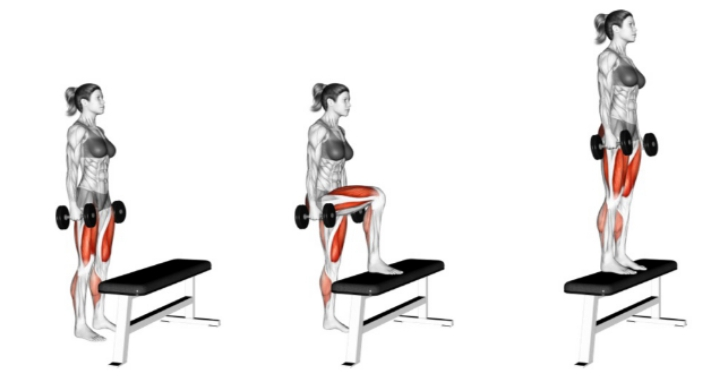
Deadlifts
Deadlifts mainly work the lower back, glutes, and hamstrings. Performing deadlifts with dumbbells helps strengthen these muscles and improve posture and stability. Hold a dumbbell in each hand in front of your thighs, stand with your feet hip-width apart, and bend at the hips to lower the dumbbells towards the floor. Keep your back straight and your core engaged, then return to the starting position by pushing through the heels.
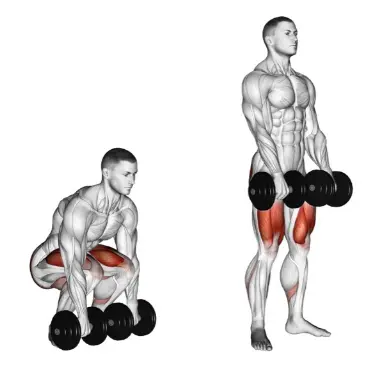
Calf Raises
Calf raises target the calf muscles and can be done with or without weights. Holding dumbbells in each hand while performing calf raises adds resistance, making the exercise more challenging. To do a dumbbell calf raise, stand tall with a dumbbell in each hand, raise your heels off the ground as high as possible, then lower them back down.
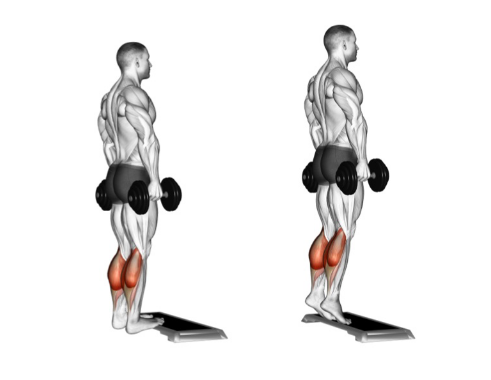
How to Perform Each Exercise Correctly
To perform each of these leg exercises with dumbbells correctly, start with goblet squats by holding a dumbbell close to your chest and squatting down, keeping your back straight. Step forward with one leg and drop your hips until both knees are at a 90-degree bend to do a lunge. For split squats and step-ups, hold dumbbells in each hand and follow the respective movement patterns, ensuring proper form and alignment throughout.
Sample Leg Workout Routine
- Warm-up: 5–10 minutes of active stretches and light cardio
- Squats: 3 sets of 10-12 reps
- Lunges: 3 sets of 10 to 12 repetitions on each leg
- Deadlifts: 3 sets of 10-12 reps
- Step-Ups: 3 sets of 10-12 reps per leg
- Calf Raises: 3 sets of 15-20 reps
- Cool down: Stretching exercises for the legs
Tips for Maximizing the Effectiveness
There are some tips for maximizing the effectiveness of leg exercises with dumbbells:
- Use Proper Form: Ensure that you’re using the correct form for each exercise to target the intended muscles and avoid injury. Keep your back straight, your core engaged, and your movements controlled.
- Start with Lighter Weights: Especially if you’re new to the exercises, start with lighter weights to focus on form and gradually increase the weight as you become more comfortable.
- Focus on Slow and Controlled Movements: Avoid using momentum to lift the weights. Instead, focus on slow and controlled movements to fully engage the muscles throughout the exercise.
- Full Range of Motion: Perform each exercise through a full range of motion to target the muscles effectively. Avoid shortening the range of motion, which can reduce the effectiveness of the exercise.
- Balance Your Routine: Include a variety of leg exercises in your routine to target all the major muscles in the legs, including quadriceps, hamstrings, and calves.
- Rest and Recovery: Give yourself a sufficient period off in between workouts and sets so that your muscles may recover and develop.
- Hydration and Nutrition: Drink lots of water and eat a healthy diet to promote the development and repair of your muscles.
Implementing these tips can help you maximize the effectiveness of your leg exercises with dumbbells and achieve your fitness goals.
Common Mistakes to Avoid
Here are some common mistakes to avoid when doing leg exercises with dumbbells:
- Rounding your back: Rounding your back during exercises like squats or lunges can strain your lower back. Throughout the exercise, keep your chest up and your back straight.
- Not warming up: Skipping a proper warm-up can increase the risk of muscle strains and injuries. Warm up your muscles with dynamic stretches or light cardio before starting your leg workout.
- Ignoring muscle imbalances: Focusing only on certain leg muscles and neglecting others can lead to muscle imbalances. Include exercises that target all major leg muscles to maintain balance and prevent injuries.
- Using momentum: Using momentum to lift the weights instead of relying on your muscles can reduce the effectiveness of the exercise. Throughout the whole range of motion, keep your muscles engaged and concentrate on making controlled motions.
- Ignoring pain: Ignoring pain during leg exercises can lead to serious injuries. If you experience sharp or persistent pain, stop the exercise and consult a healthcare professional.
Conclusion
In conclusion, including leg exercises with dumbbells into your workout routine offers numerous benefits for strength, muscle definition, balance, and joint health. By following safety precautions, warming up properly, and avoiding common mistakes, you can perform leg exercises with dumbbells safely and effectively. Remember to start with lighter weights, maintain proper form, and listen to your body to prevent injuries and maximize results. With a well-rounded leg workout routine that includes exercises like squats, lunges, deadlifts, step-ups, and calf raises, you can sculpt and strengthen your lower body while improving your overall fitness and performance.
FAQs
Q. Can I use kettlebells instead of dumbbells for these leg exercises?
While kettlebells can be used for some leg exercises, dumbbells are generally more versatile and easier to handle, especially for beginners.
Q. How often should I perform leg exercises with dumbbells?
It’s recommended to perform leg exercises with dumbbells 2-3 times per week, allowing for rest days in between workouts.
Q. Will these exercises help me lose weight in my legs?
While these exercises can help tone and strengthen your leg muscles, they are most effective when combined with a balanced diet and an overall fitness routine for weight loss.
Q. Can I do these exercises at home without a gym membership?
Yes, all of these exercises can be done at home with a pair of dumbbells and a sturdy surface for step-ups.
Q. How long would it take for these leg workouts to show results?
Results can vary depending on your fitness level and consistency, but with regular workouts, you may start to see improvements in leg strength and muscle definition within a few weeks.
